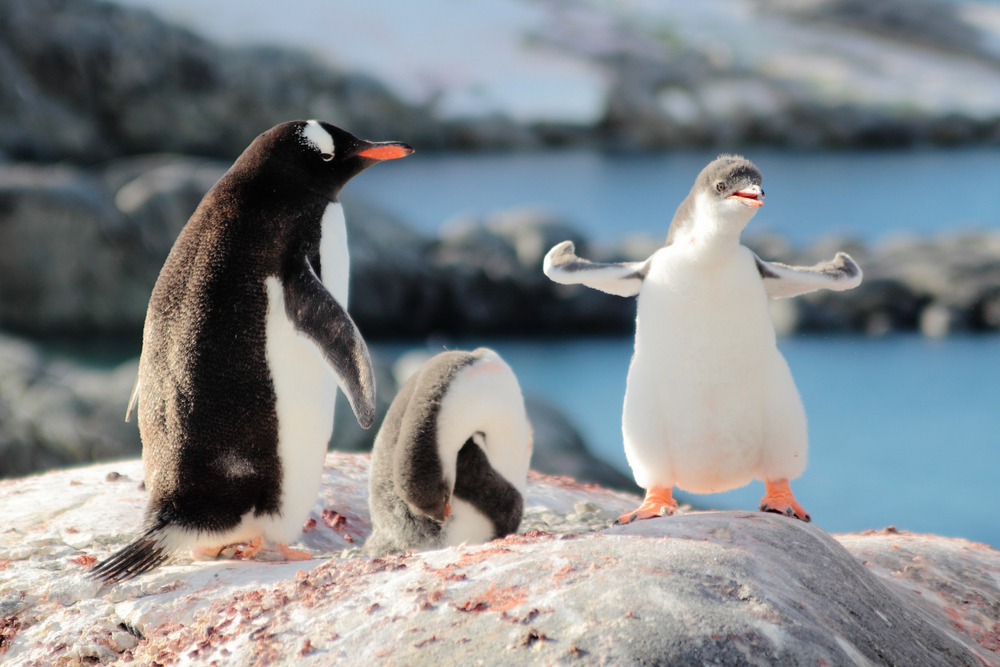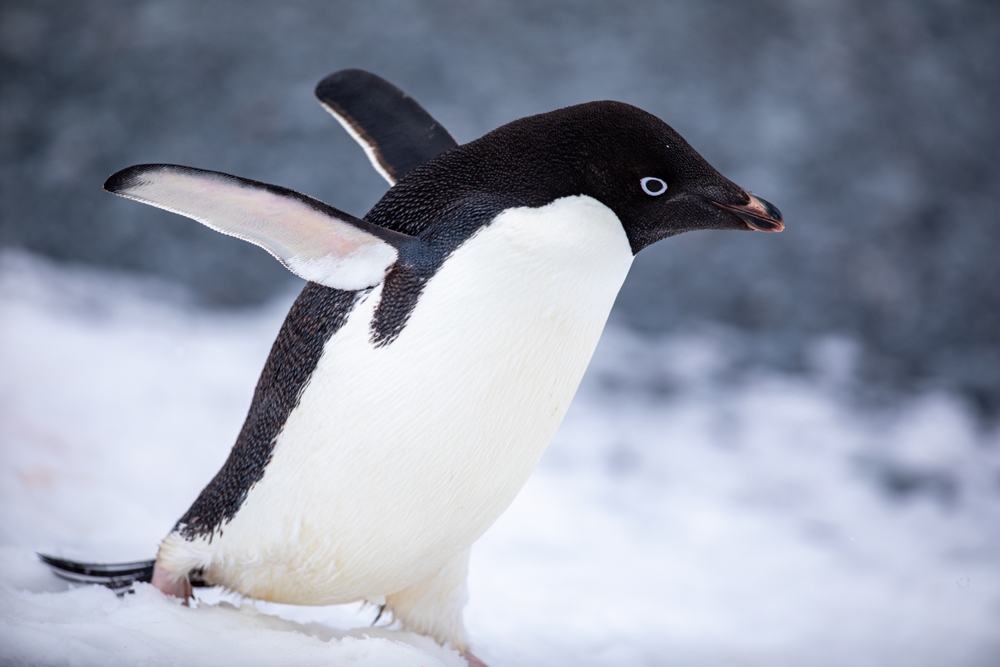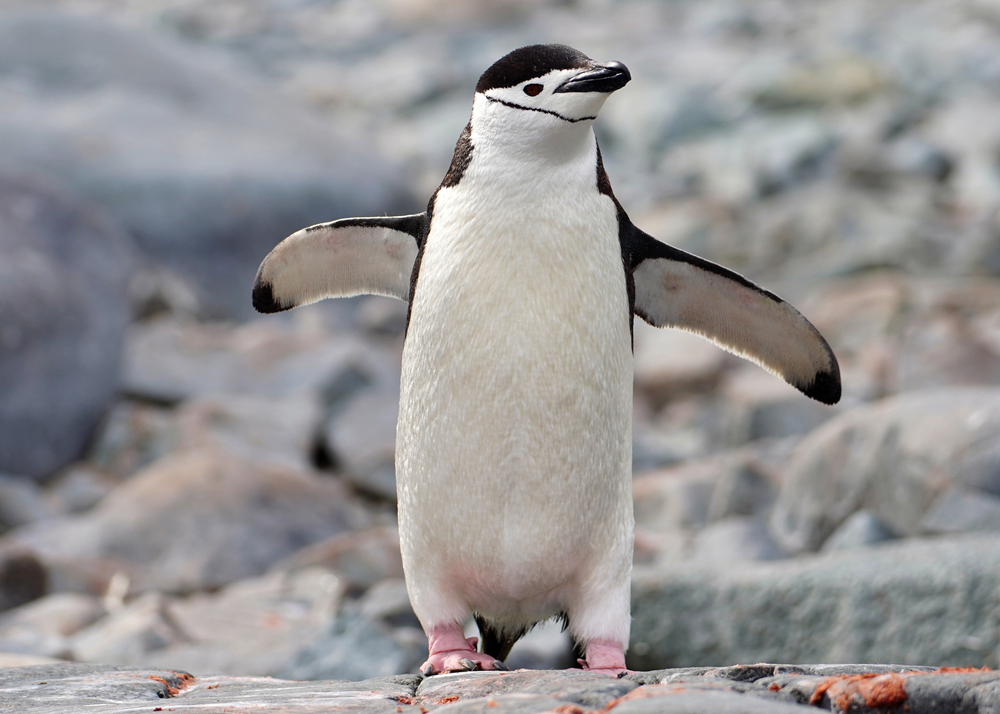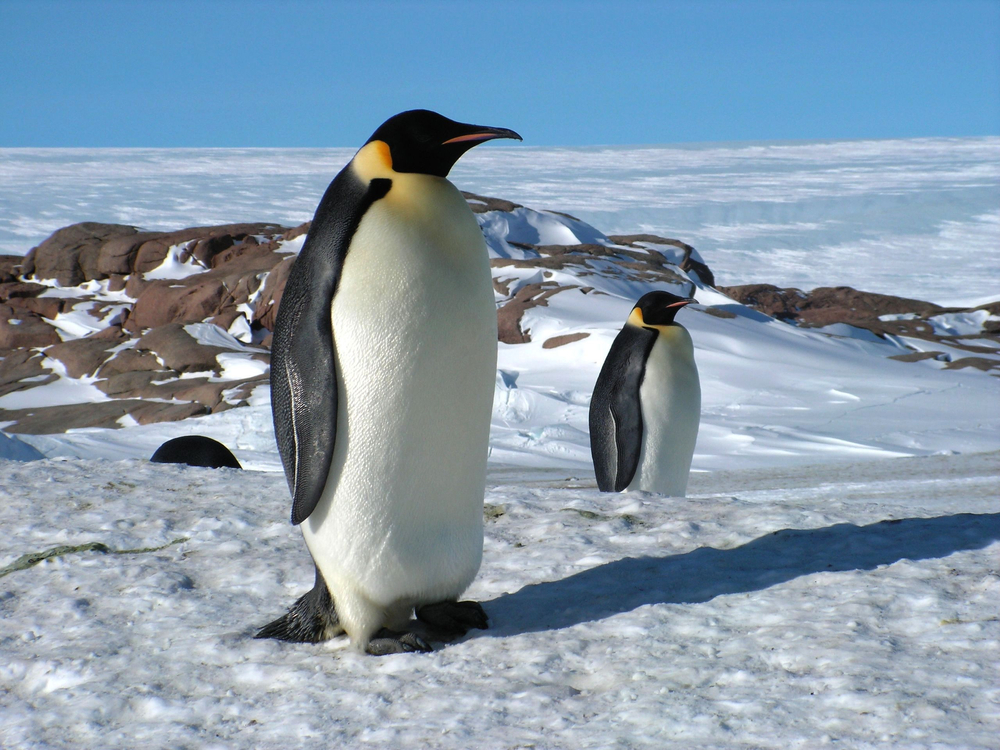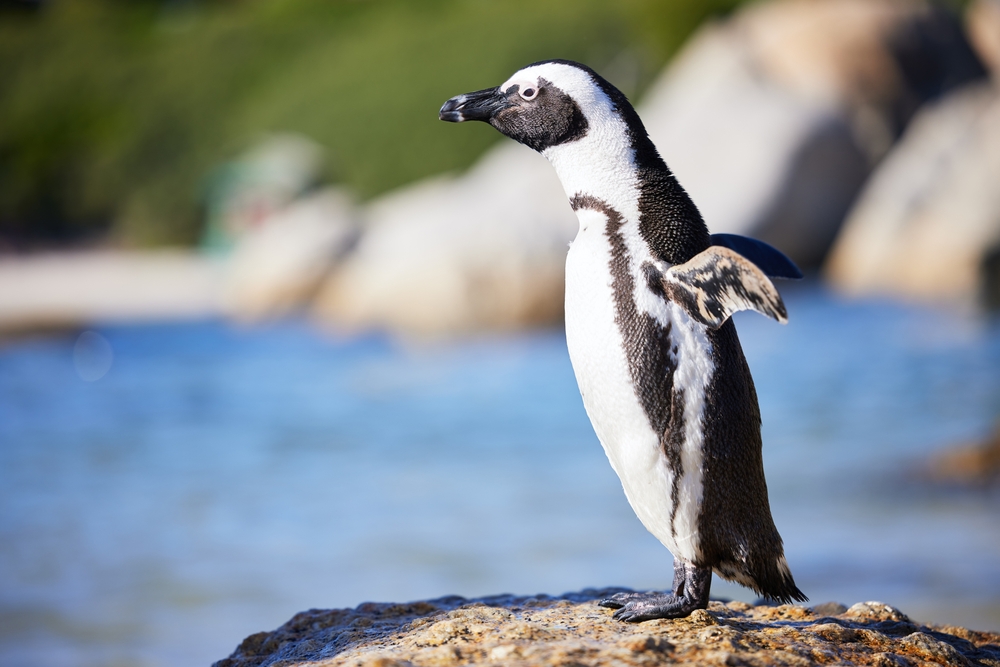The Gentoo Penguin’s closest relatives are the Adélie Penguin and the Chinstrap Penguin, as all three belong to the genus Pygoscelis. Together, they are known as the “brush-tailed penguins” due to their stiff, wedge-shaped tails.
About
The Gentoo Penguin (Pygoscelis papua) is a charismatic seabird of the Spheniscidae family, recognized as the third largest penguin species after the Emperor and King. It is native to sub-Antarctic islands and the Antarctic Peninsula, with strong populations in the Falkland Islands, South Georgia, and Kerguelen Islands. Known for their curious nature and energetic movements, Gentoos are among the most active and endearing penguins to observe.
Measuring 75 to 90 centimeters (30 to 35 inches) in height and weighing 5 to 8.5 kilograms (11 to 19 pounds), Gentoo Penguins are easily identified by their bright orange-red beaks, white eye patches that connect across the head, and long tail feathers, which are more prominent than in other penguins. Their plumage is classic black above and white below, aiding in camouflage while swimming.
Gentoo Penguins are the fastest underwater swimmers of all penguins, reaching speeds up to 36 km/h (22 mph). Their diet is diverse, consisting mainly of krill, fish, and squid, varying by location and season. They are adept divers, capable of plunging more than 200 meters (656 feet) in search of food, though most dives are much shallower.
Breeding occurs in large colonies on ice-free beaches or grasslands, where pairs build nests of stones, grass, and feathers. Both parents share in incubation and feeding duties. Two eggs are usually laid, and often both chicks survive, which is uncommon among many penguin species.
The Gentoo Penguin is currently listed as Least Concern, though local populations are vulnerable to climate change, fisheries competition, and human disturbance. Their adaptability has allowed them to thrive in a wide range of habitats, from icy shores to tussock-covered islands.
Gentoo Penguins, with their speed, charm, and resilience, symbolize the vitality of the Southern Ocean’s ecosystems.
Physical Characteristics
Gentoo Penguins are medium-to-large penguins recognized for their bright orange bills and the wide white stripe across the top of their heads. They are the third-largest penguin species after Emperor and King Penguins.
-
Coat/Plumage: Their plumage is black on the back and head with a distinctive broad white stripe running across the crown from eye to eye. The underparts are pure white, while the tail is unusually long for a penguin and stiff, often held upright.
-
Face: They have bright red-orange bills and white patches around the eyes. Their eye color is typically dark brown.
-
Body: Stout and torpedo-shaped, adapted for strong swimming. A thick fat layer provides insulation against cold sub-Antarctic waters.
-
Flippers: Black above and white below, functioning as powerful paddles to propel them through water.
-
Feet: Bright orange and webbed, with strong claws that aid in climbing rocky shorelines.
-
Tail: Longer than most penguins, stiff, and wedge-shaped, frequently used as a balance point when moving on land.
Size:
-
Height: About 30 to 35 in (76 to 90 cm).
-
Weight: Ranges from 11 to 19 lbs (5 to 8.5 kg), with males generally larger than females.
Gentoo Penguins are easily recognized by their bright coloring, long tails, and distinctive white head stripe. They are also the fastest penguins underwater, capable of reaching speeds up to 22 mph (36 km/h).
Reproduction
The reproductive cycle of Gentoo Penguins is closely tied to the sub-Antarctic summer and varies slightly across their wide geographic range.
-
Mating and Courtship:
-
Gentoo Penguins are generally monogamous within a breeding season, with many pairs reuniting year after year.
-
Courtship rituals include bowing, vocal displays, and the presentation of pebbles by males to females—a behavior that strengthens pair bonds.
-
-
Nesting:
-
They build nests from stones, grass, moss, and feathers, often forming circular mounds.
-
Colonies are typically smaller than those of Adélie or Chinstrap Penguins, ranging from a few dozen to several thousand pairs.
-
-
Egg Laying and Incubation:
-
Females usually lay two eggs of similar size.
-
Both parents share incubation duties, alternating shifts of 1 to 3 days.
-
The incubation period lasts about 34 to 37 days.
-
-
Chick Development:
-
Chicks hatch covered in gray down and are brooded constantly for the first few weeks.
-
Parents feed them through regurgitation, making frequent foraging trips to the sea.
-
-
Crèche and Independence:
-
At about 3 weeks of age, chicks begin to gather in small groups called crèches, which provide protection and warmth.
-
Fledging occurs at 7 to 9 weeks, when chicks molt into waterproof feathers and head out to sea.
-
Gentoo Penguins’ flexible breeding schedule, strong pair bonds, and attentive parental care contribute to higher chick survival rates compared to some other penguin species. However, food shortages and predation still pose challenges.
Lifespan
Gentoo Penguins, the third-largest penguin species, live in sub-Antarctic regions and along the Antarctic Peninsula. Their lifespan varies depending on conditions in the wild versus managed care.
-
Lifespan in the Wild:
Gentoo Penguins typically live 15 to 20 years in their natural habitat. Many chicks do not survive their first year due to predation or food shortages, so reaching adulthood is a major survival milestone. -
Lifespan in Captivity:
In aquariums and wildlife parks with consistent food supply and veterinary care, Gentoos can live longer, sometimes exceeding 25 years.
Threats to the Gentoo Penguin:
-
Predation: Eggs and chicks are vulnerable to skuas, sheathbills, and giant petrels, while leopard seals prey on adults at sea.
-
Food Availability: Declines in krill and fish stocks, often caused by climate change and commercial fishing, directly affect survival and breeding success.
-
Climate Change: Shifting sea ice and warming waters alter prey distribution and can disrupt breeding colonies.
-
Human Disturbance: Growing tourism in sub-Antarctic regions can disturb nesting areas if not carefully managed.
Conservation efforts under the Antarctic Treaty System and establishment of marine protected areas help safeguard Gentoo Penguins, which are currently listed as Least Concern, though some regional populations are declining.
Eating Habits
Gentoo Penguins are opportunistic carnivores that feed in the cold, productive waters of the Southern Ocean.
-
Diet:
Their diet is dominated by Antarctic krill, small fish (such as Antarctic silverfish), and squid. The proportion of each varies depending on season and local availability. -
Foraging Strategy:
Gentoo Penguins are excellent pursuit divers and the fastest underwater swimmers among penguins, reaching speeds up to 22 mph (36 km/h).
They usually dive to depths of 65 to 200 ft (20 to 60 m) but are capable of diving over 600 ft (180 m) when necessary. -
Hunting Behavior:
They forage both individually and in groups, often targeting krill swarms and fish schools. Group hunting increases efficiency and provides some protection against predators. -
Feeding the Young:
Adults regurgitate partially digested krill, fish, and squid to feed their chicks. During the breeding season, parents alternate foraging trips to provide steady nourishment. -
Seasonal Variation:
Krill is the primary food source in summer, while fish and squid become more important during winter months or in areas where krill is less abundant.
Gentoo Penguins’ flexible diet and exceptional swimming speed allow them to adapt to varying prey conditions, though they remain vulnerable to climate-driven changes and commercial fishing pressures on krill stocks.
Uniqueness
The Gentoo Penguin (Pygoscelis papua) stands out among penguins with several distinctive traits:
-
Third-Largest Penguin: After the Emperor and King, the Gentoo is the third-largest penguin species, reaching up to 35 in (90 cm) in height.
-
Fastest Swimmer: They are the fastest underwater swimmers of all penguins, reaching speeds up to 22 mph (36 km/h).
-
Distinctive Head Stripe: A wide white band extends across the top of the head from eye to eye, making them easy to recognize.
-
Bright Orange Features: Their bright orange beak and vivid orange feet give them a colorful appearance compared to many other penguin species.
-
Long Tail Feathers: Gentoos have unusually long, stiff tail feathers that are often held upright, adding to their unique silhouette.
-
Flexible Breeders: Unlike some penguin species that are tightly synchronized, Gentoos can breed over a long season, with timing varying by location.
-
Wide Distribution: They are one of the most widely distributed penguin species, found on the Antarctic Peninsula and many sub-Antarctic islands.
The Gentoo Penguin’s combination of size, speed, and distinctive markings makes it one of the most recognizable and ecologically adaptable penguin species in the Southern Ocean.
Be the First to Share Photos of This Species.
FAQ’s
1. What is the species closest to the Gentoo Penguin?
2. How does the Gentoo Penguin compare to other penguins?
Gentoo Penguins are the third-largest penguin species, smaller than Emperor and King Penguins but larger than Adélie and Chinstrap Penguins.
They are also the fastest swimmers among penguins, reaching speeds of 22 mph (36 km/h). Their long breeding season and wide range make them more flexible and adaptable than many other penguin species.
3. What national parks provide an opportunity to see the Gentoo Penguin?
Gentoo Penguins are found across the Antarctic Peninsula and several sub-Antarctic islands, many of which are protected:
-
Antarctic Peninsula (various ASPAs under the Antarctic Treaty System) – major Gentoo breeding colonies.
-
South Georgia and the South Sandwich Islands (UK Overseas Territory) – large Gentoo populations within marine protected zones.
-
Falkland Islands (Islas Malvinas) – important colonies protected through local reserves.
These parks and protected areas provide some of the best opportunities to see Gentoos in their natural habitats.



































































